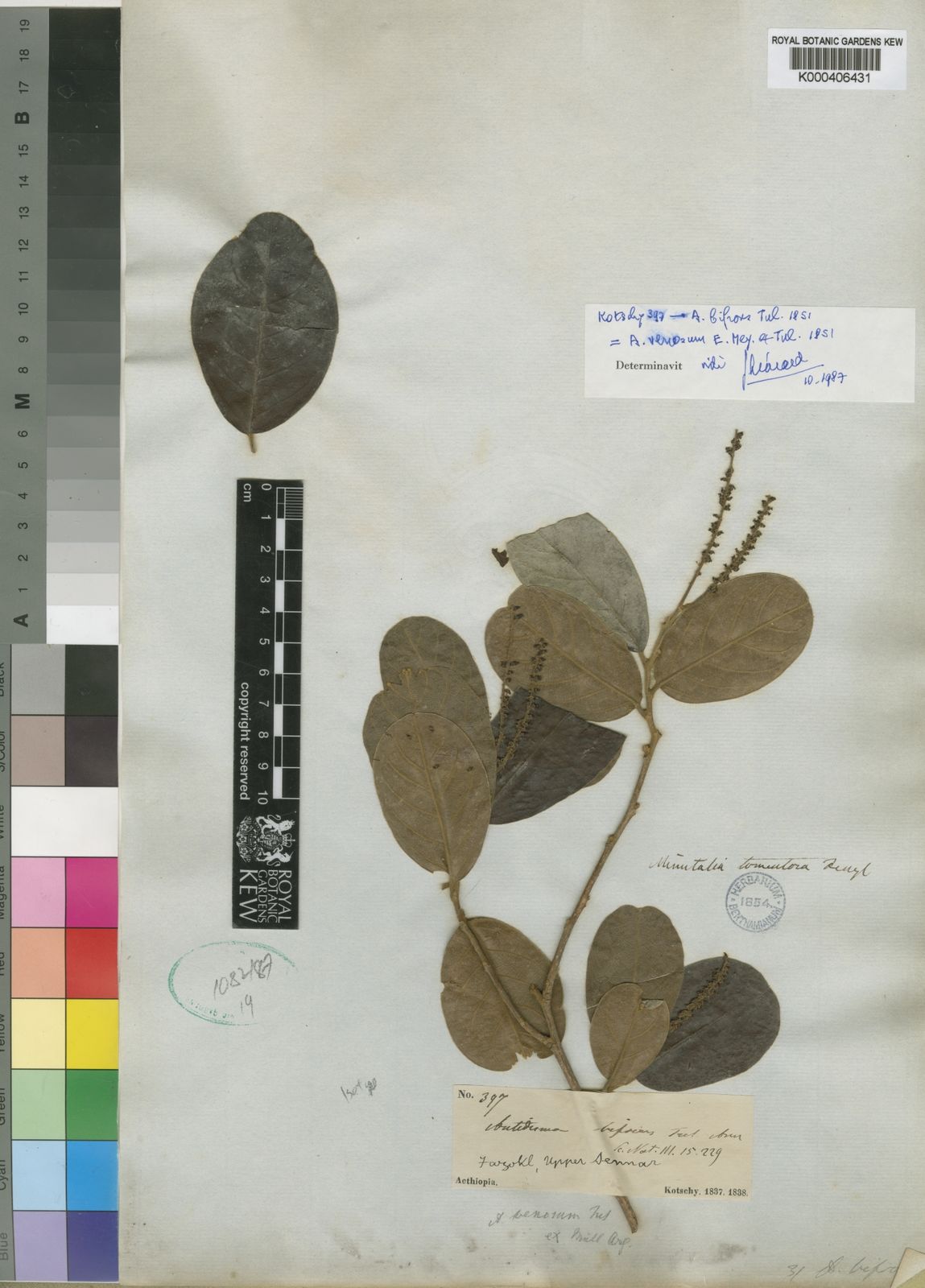Family: Phyllanthaceae
Author: E.Mey. ex Tul.
Bibliography: Ann. Sci. Nat., Bot. sér. 3, 15:232. 1851
Year: 1851
Status: accepted
Rank: species
Genus: Antidesma
Vegetable: False
Observations: Trop. & S. Africa, Madagascar, S. China to Indo-China
Description
The Tassel-berry, scientifically known as Antidesma venosum, is a notable plant with a widespread presence in tropical and southern Africa, extending its reach to Madagascar, southern China, and Indo-China. This extraordinary species belongs to the Phyllanthaceae family, a diverse group of flowering plants known for their ecological and medicinal significance.
First documented in 1851 by E. Mey. ex Tul. in the renowned Annales des Sciences Naturelles, Botanique série 3, the Tassel-berry quickly became recognized for its distinctive qualities and adaptability to various climates. The plant thrives in a variety of environments, showcasing its resilience and versatility across different regions.
Antidesma venosum is celebrated for its lush foliage and the striking appearance of its berry clusters, which resemble tassels, hence its common name. These berries not only add aesthetic value to natural landscapes but also play a vital role in the local ecosystems. The berries are a crucial food source for various bird species, aiding in seed dispersion and promoting the health of their habitats.
Historically, the Tassel-berry has also been utilized in traditional medicine. Indigenous communities across its native range have leveraged the plant’s properties for treating a variety of ailments, demonstrating the plant’s significance beyond its ecological contributions.
In terms of horticulture, the Tassel-berry is appreciated for its ornamental value. Gardeners and landscapers often incorporate the plant into their designs to bring a touch of the wild to cultivated spaces. Its ability to prosper in different environments makes it a favored choice for enhancing biodiversity in gardens and parks.
In summary, Antidesma venosum, or the Tassel-berry, is more than just a visually appealing plant. Its ecological importance, medicinal applications, and ornamental uses underline its multifaceted value. From the tropical forests of Africa to the lush landscapes of Indo-China, this plant continues to thrive and adapt, making a significant impact on both natural and human communities.
Common Names
Kon: fitidi, fitidi di nseke, fuitidi
Run: munzikazika, umuhogonro, umukongorabugita, umutorogoro, umutuedue
Eng: tassel-berry
En: Tassel-berry, Tasselberry
Af: Tosslebessie, Voëlsitboom
Rn: Munzikazika, Umuhogonro, Umukongorabugita, Umutorogoro, Umutuedue
Kg: Fitidi, Fitidi di nseke, Fuitidi
Synonyms
- Antidesma boivinianum (Baill.)
- Antidesma natalense (Harv.)
- Antidesma bifrons (Tul.)
- Antidesma fuscocinereum (Beille)
- Minutalia tomentosa (Fenzl)
- Antidesma venosum var. thouarsianum (Tul.)
- Antidesma neriifolium (Pax & K.Hoffm.)
Distribution
- Angola (native)
- Benin (native)
- Botswana (native)
- Burkina (native)
- Burundi (native)
- Cameroon (native)
- Cape Provinces (native)
- Caprivi Strip (native)
- Central African Repu (native)
- Chad (native)
- China South-Central (native)
- China Southeast (native)
- Congo (native)
- Ethiopia (native)
- Gabon (native)
- Gambia (native)
- Ghana (native)
- Guinea (native)
- Guinea-Bissau (native)
- Hainan (native)
- Ivory Coast (native)
- Kenya (native)
- KwaZulu-Natal (native)
- Laos (native)
- Liberia (native)
- Malawi (native)
- Mali (native)
- Mozambique (native)
- Niger (native)
- Nigeria (native)
- Northern Provinces (native)
- Rwanda (native)
- Senegal (native)
- Sierra Leone (native)
- Somalia (native)
- Sudan (native)
- Swaziland (native)
- Tanzania (native)
- Thailand (native)
- Togo (native)
- Uganda (native)
- Vietnam (native)
- Zambia (native)
- Zaïre (native)
- Zimbabwe (native)
Additional Images
Fruit
Taken Apr 30, 2016 by Manie Maree (©)
Taken Apr 30, 2016 by Manie Maree (©)
Taken Apr 30, 2016 by Manie Maree (©)
Taken Apr 30, 2016 by Manie Maree (©)
Taken Apr 30, 2016 by Manie Maree (©)
Other
Taken Jun 4, 2021 by pedrogc — (cc-by-sa)
Taken Apr 30, 2016 by Manie Maree (©)
Bark
Taken Apr 30, 2016 by Manie Maree (©)
Taken Apr 30, 2016 by Manie Maree (©)
Taken Apr 30, 2016 by Manie Maree (©)
Taken Apr 27, 2016 by Manie Maree (©)
Taken Apr 30, 2016 by Manie Maree (©)
Leaf
Taken Apr 30, 2016 by Manie Maree (©)
Taken Apr 30, 2016 by Manie Maree (©)
Taken Apr 30, 2016 by Manie Maree (©)
Taken Apr 30, 2016 by Manie Maree (©)
Taken Apr 30, 2016 by Manie Maree (©)
Flower
Taken Apr 30, 2016 by Manie Maree (©)
Taken Apr 30, 2016 by Manie Maree (©)
Taken Apr 30, 2016 by Manie Maree (©)
Taken Apr 30, 2016 by Manie Maree (©)
Taken Apr 30, 2016 by Manie Maree (©)
Habit
Taken Apr 30, 2016 by Manie Maree (©)
Taken Apr 30, 2016 by Manie Maree (©)
Taken Apr 30, 2016 by Manie Maree (©)
Taken Apr 27, 2016 by Manie Maree (©)
Taken Apr 30, 2016 by Manie Maree (©)

© copyright of the Board of Trustees of the Royal Botanic Gardens, Kew.
Sources
- WFO (No URL)
- IPNI (No URL)
- GBIF (https://www.gbif.org/species/3076520)
- POWO (http://powo.science.kew.org/taxon/urn:lsid:ipni.org:names:339151-1)
- PlantNet (https://identify.plantnet.org/species/the-plant-list/Antidesma venosum E.Mey. ex Tul.)



























